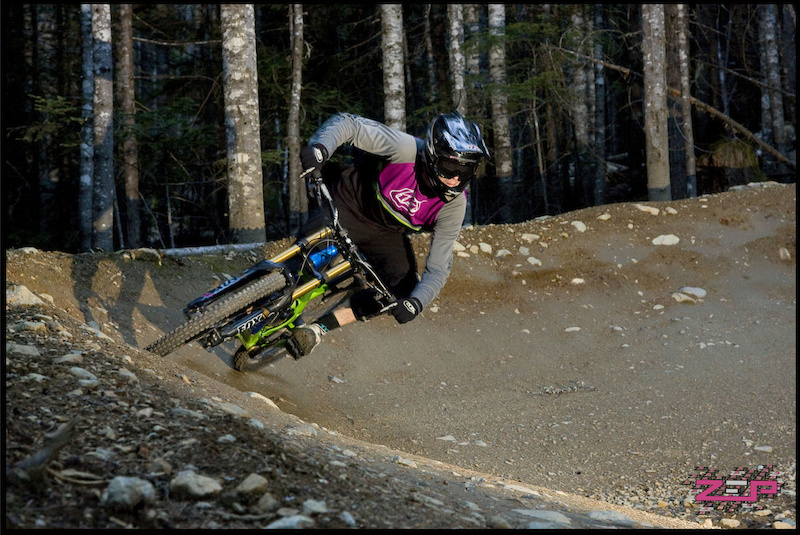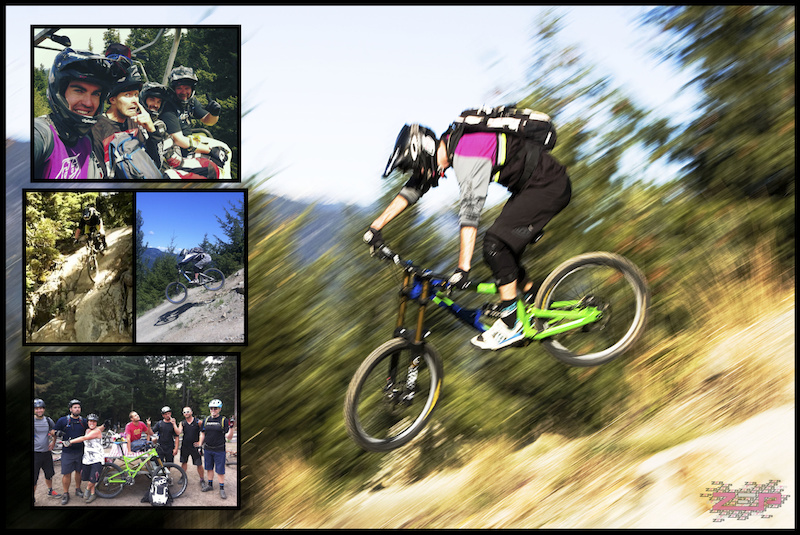In the first of our ZEP Mountain Bike Camps Mythbusters Series (see here) we took a look at why certain ‘myths’ in mountain bike technique exist, and what are some of the key ways to look at learning, to help understand new techniques and progress in your riding. These articles are intended for any rider interested in learning some core techniques to progress their skills, as well as for instructors/coaches who are looking to improve the quality and consistency of their lessons.
In this article we’ll be taking a look at the following myth; “I read somewhere that you shouldn’t brake through corners and I’ve been trying to do this for ages, but just can’t do it.” While the following information may seem obvious to some people, this is one of the most common myths we find coaching riders (even experts!) every year, and when addressed, can be one of the easiest ways to improve a riders confidence, speed and flow through corners. To understand why this myth typically causes more problems than it fixes, let’s first take a look at how braking actually affects the bike and rider.
The Negative Affects of Braking
– Typically, less traction (though sometimes braking can actually increase traction on the front wheel)
– Less efficient/supple suspension.
– Harder to lean (both bike and body), and therefore control the direction of the bike.
– Riders centre of mass shifts forward, potentially reducing stability.
– Riders’ muscles stiffen, reducing mobility.
– Harder for wheels to roll over bumps smoothly.
It seems like braking is a really bad idea… maybe we should never do it?! Of course, this is not possible because we need to control our speed… a fairly fundamental part to safe riding. So, the challenge is to control our speed while minimizing the negative effects of braking. How to we do this? We simply need to gain a better understanding and skill of choosing when to brake.
When To Brake The idea of when to brake is to allow a rider to control their speed, while minimizing the negative affects of braking.
Riders can do this by actively scanning the trail with their vision and selecting when to brake, by choosing zones (sections of trail) to brake more or less in. A classic example is corners – brake more before the corner, brake less through the corner. This requires a rider to actively choose when to brake more and when to brake less, instead of absent-mindedly dragging both brakes the same amount through the entire corner. Another example could be on a rough, technical section of trail and the same idea would apply, brake more beforehand to brake less during, so the bike and rider can better deal with the rougher terrain.
Maintaining a stable position on the bike is key to confident, consistent cornering… learning when and how to use the brakes can greatly help this.
More or Less vs. Brake or no Brake We know when to brake, but how should we brake?
In a downhill corner, especially one that is banked/bermed, the bike will naturally want to accelerate. This often causes the bike to move forward relative to the rider, leaving the rider in the ever familiar ‘off the back’ feeling, as they exit the corner. Therefore, letting the brakes off completely can often cause the rider to lose stability and control through the corners, which makes it especially difficult if a corner immediately leads into another one, like on Ninja Cougar in the Whistler Mountain Bike Park. Simply put, the idea of ‘braking before the corner and not through the corner’, while intending to help, typically causes more problems than it fixes.
Instead, the language of more braking before the corner, and less braking during achieves the desired outcome – to get your speed controlled before the corner, while providing the added bonus of making it much easier to control the bike through the corner. To understand this a little more let’s take a look at the differences between braking to slow down and braking to not speed up.
Claire can corner faster than most…
“There are so many elements of cornering and braking is a big one. I always tell my clients that it isn’t realistic to not brake in the corners. It’s more about where and how much to achieve maximum exit speed. “UCI World Cup DH Racer, UCI World Champion DH Bronze Medalist, Kovarik Racing Coach, Claire Buchar
Braking to Slow Down vs. Braking to not Speed up Using both brakes vs. only the rear brake
Braking to slow down causes the negative effects of braking to happen significantly (suspension stiffens, traction is reduced, etc)… which is why we try to do this before the corners. Riders should use both brakes to slow down, applying the brakes gradually, keeping the power consistent, for smooth, skid-free braking.
Braking to not speed up (to control or maintain speed) however, causes little to no negative effects of braking… and this is why we can do this through the corner. Furthermore, it helps keep the rider centred by keeping the bike “underneath” the rider, instead of it accelerating ahead of them. A rider can use just the rear brake, to not speed up… we call this technique Trail Braking. While controlling speed, this also keeps the front brake off, ensuring the front wheel has maximum traction and the fork tracks smoothly. This simple braking technique has helped countless ZEP clients improve their confidence, control and speed through downhill corners. Loose, connecting corners are another great example of when a little trail braking can help control, speed and flow. A little rear brake through a downhill corner can do far more good than bad… it’s all about pros and cons.
Over time and with focused practice, a rider can ultimately learn to let the brakes off completely, in more and more corners. However, there will always be downhill corners where a rider can use trail braking through the corner for better control, stability and exit speed. Racers can even use this technique to gradually build up there confidence and speed through corners that they don’t know well, by gradually trail braking less and less, depending on what the section of corner and trail will allow them to do.
Here we can see Chris gently trail braking (his rear brake is on the left) through this sweeping, downhill corner.
“For most people not braking through corners is unrealistic; even for me, there?s a bunch of times where a little braking through a corner makes sense. Taking your chain off can teach you about your braking and line choice in corners. You won’t have pedalling to get you out of trouble, so how you use the brakes to control your speed into, through and out of the corner, is even more important.” Downhill Mountain Bike Racing Legend, Chris “Karver” Kovarik.
Practicing more brake before the corner and less brake (rear only) through the corners and you should find yourself:
– Linking corners more easily
– Maintaining speed through corners better (meaning a faster exit speed)
– Maintaining a more centred, stable body position
– And maybe even going into them faster, in the first place!
So, try to open your mind when it comes to biking techniques. Try not to think of them as right or wrong, but more pros and cons. It will allow you the freedom to experiment and ultimately gain a much deeper understanding of how, why and when certain techniques can be used. Mountain biking involves so many constantly changing variables, that ‘right’ techniques are often not the case in a different situation, and vice versa with ‘wrong’ techniques.
Stay safe, progress in small steps and happy riding people!
Paul
ABOUT THE AUTHOR
Paul Howard is the Owner-Director & Head Coach of ZEPtechniques, Technical Director of the Professional Mountain Bike Instructor Association, Head Snowboard Trainer for Whistler Blackcomb SnowSchool, Technical Education Committee & 2015 Interski Team Member for the Canadian Association of Snowboard Instructors, and has been teaching mountain biking and training mountain bike instructors around the world, since the late 90’s.
ABOUT ZEP
ZEPtechniques is a Whistler-based mountain bike camps and instructor training company. Established in 2006, ZEP offers single and multi-week, adult specific rider improvement camps, as well as weekly clinics, private lessons and tours. ZEP’s Instructor Training services include the industry’s original, multi-week mountain bike instructor training camps; training riders four days per week with evening seminars on suspension set up, bike mechanics, nutrition, as well as strength & conditioning sessions, all with industry experts. As developers of the internationally available Professional Mountain Bike Instructors Certifications and Directors of the PMBI Association, ZEP has long played a key role in establishing and improving the finest teaching practices and instructor certifications, within mountain biking.
ZEP is proudly supported by
Transition Bikes
ANVL Components
Fox Racing Shox
Troy Lee Designs
Five Ten
MRP
EVOC
Vorsprung Suspension
Reel Cameras
Spun Studios
ZEP Facebook
ZEP Twitter | @ZEPMTBCamps
ZEP Instagram | @zepmtbcamps
Photos
Tim Hailwood Photography – Bike Park Photos




